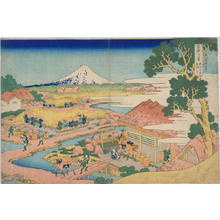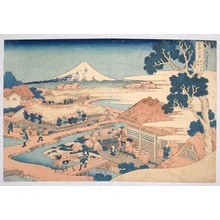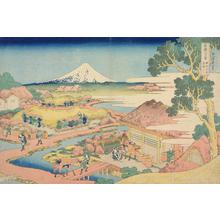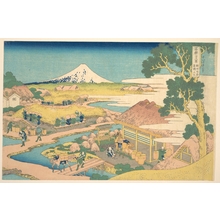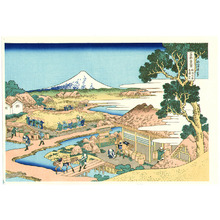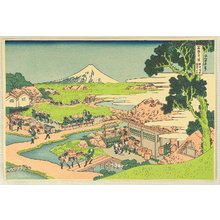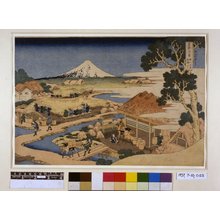Katsushika Hokusai创作的日本版画《Mount Fuji from the Tea Plantation of Katakura in Suruga Province》
标题:Mount Fuji from the Tea Plantation of Katakura in Suruga Province
日期:c. 1830 - 1834
详情:更多信息...
来源:Honolulu Museum of Art
浏览所有5,476幅版画...
描述:
In this print Hokusai depicts the work and life of a tea plantation in Suruga province (now included in Shizuoka prefecture). Although no one knows when tea cultivation started in Shizuoka, its production in this region was already renowned during the Muromachi period (1329-1573). Since that time, Shizuoka has provided tea to all Japan, and now even to the world. One of Hokusai’s detailed compositions, the print shows a plantation edged by a winding stream in the middle ground. Rows of women wearing round bamboo hats pick tea leaves. Across another green field, probably another tea field, the snow-covered Mount Fuji rises. In the foreground, men transport the freshly picked tea leaves to storage on horseback and on their backs. Although of interest for what the composition shows of the workings of a tea plantation, critics find that it is too detailed and crowded – perhaps more appropriate for a book illustration than for a single-sheet print. Hokusai, formerly a book illustrator, here reveals his previous training and habits. But the coloristic treatment helps the overall clarity of the design. The key-block was printed in black. (The Asian Art Museum of San Francisco, HOKUSAI AND HIROSHIGE – Great Japanese Prints from the James A. Michener Collection, Honolulu Academy of Arts: The Asian Art Museum of San Francisco, 1998 Page 98. 50Cat. ) ***************** Suruga Province (now part of Shizuoka Prefecture) features prominently in Hokusai’s Thirty-six Views of Mount Fuji series, with four prints dedicated to it. This print depicts what must have been a typical workday on the Katakura tea plantation. Shizuoka was known for tea production as early as the Muromachi period (1329-1573), and tea remains an important crop for the region today, being exported throughout Japan and the rest of the world. The print is filled with details: rows of women picking tea leaves, a man packing them into baskets, other men carrying them to a shed. Near the shed one of the workers repairs a horse’s straw shoe, while another attempts to coax his reluctant beast across a narrow bridge. Echoed by the shapes of the village rooftops, Mount Fuji rising from the plain adds a sense of stability and shelter to the scene. “Hokusai’s Summit: Thirty-six Views of Mount Fuji” (09/24/2009-01/06/2010) ******************************

